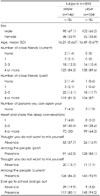1. Korean Educational Development Institute. Brief statistics on Korean education. Seoul: Ministry of Education;2014.
2. Ko BJ, Shin YM. School refusal and drop out. In : Hong KE, editor. Korean textbook of child psychiatry. Seoul: Hakjisa;2014. p. 456–461.
3. Yang MJ, Ji SH, Kim TS, Lee JY, Hong JY. The development of the Korean youth social withdrawal scale. Asian J Educ. 2007; 8:119–134.

4. Baek HT, Kim BN, Shin MS, Ahn DH, Lee YS. Development of parental screening questionnaire for hidden youth. J Korean Acad Child Adolesc Psychiatry. 2011; 22:262–270.

5. Smollar J, Youniss J. Social development through friendship. In : Kenneth HR, Hildy SR, editors. Peer relationships and social skills in childhood. NewYork: Springer-Verlag;1982. p. 279–298.
6. Lee YJ, Choi TY, Lee YS. Problematic internet use in Korean adolescents with social withdrawal. In : Takeda M, editor. Psychiat Neurol Jap 2013: proceedings of the 108th annual meeting of the Japanese society of psychiatry and neurology; 2012 May 24-26; Sapporo, Japan: 2013. p. 541–545.
7. Phil E. Friendship in childhood and adolescence. New York: Routledge;2013.
8. Saito T. Why do Japanese youths witidraw?. In : In : Miyanishi T, editor. Why does a Japanese young man stay indoors without communicating with another person? proceedings of the university partners symposium in Japan and Korea; 2010 Jan 20; Wakayama, Japan: Wakayama University;2010. p. 10–25.
9. Yeo IJ. Social withdrawal. Seoul: Jihyemoonhak;2005.
10. Furlong A. The Japanese hikikomori phenomenon: acute social withdrawal among young people. Sociol Rev. 2008; 56:309–325.

11. Lee YS, Lee JY, Choi TY, Choi JT. Home visitation program for detecting, evaluating and treating socially withdrawn youth in Korea. Psychiatry Clin Neurosci. 2013; 67:193–202.

12. Saito T. Shakaiteki hikikomori: owaranai shishunki. Tokyo: PHP Kenkyuujyo;1998.
13. Itou J. Guideline on mental health activities in communities for social withdrawal. Tokyo: Ministry of Health, Labor, and Welfare;2003.
14. Lee KM, Koo JG, Kim EJ, Lee SH. The psychosocial characteristics of oiettolie adolescents. Korean J Couns Psychother. 2001; 13:147–162.
15. Kato TA, Tateno M, Shinfuku N, Fujisawa D, Teo AR, Sartorius N, et al. Does the 'hikikomori' syndrome of social withdrawal exist outside Japan? A preliminary international investigation. Soc Psychiatry Psychiatr Epidemiol. 2012; 47:1061–1075.

16. Sarchione F, Santacroce R, Acciavatti T, Cinosi E, Lupi M, Di Giannantonio M. Hikikomori, clinical and psychopathological issues. Res Adv Psychiatry. 2015; 2:21–27.

17. Teo AR, Fetters MD, Stufflebam K, Tateno M, Balhara Y, Choi TY, et al. Identification of the hikikomori syndrome of social withdrawal: psychosocial features and treatment preferences in four countries. Int J Soc Psychiatry. 2015; 61:64–72.

18. Teo AR. A new form of social withdrawal in Japan: a review of hikikomori. Int J Soc Psychiatry. 2010; 56:178–185.

19. Teo AR, Gaw AC. Hikikomori, a Japanese culture-bound syndrome of social withdrawal?: a proposal for DSM-5. J Nerv Ment Dis. 2010; 198:444–449.
20. Sakai M, Iishikawa S, Sato H, Sakano Y. Development of hikikomori behavior checklist (HBCL) and examination of its reliability and validity. Jpn J counsel Sci. 2004; 37:210–220.
21. Lee YH, Song JY. A study of the reliability and the validity of the BDI, SDS, and MMPI-D scales. Korean J Clin Psychol. 1991; 10:98–113.
22. Won HT, Park HS, Kwon SM. A study on the development of the Korean versions of panic scales. Korean J Clin Psychol. 1995; 14:95–110.
23. Lee JY, Choi CH. A study of the reliability and the validity of the Korean versions of Social Phobia and Scales (K-SAD, K-FNE). Korean J Clin Psychol. 1997; 16:251–264.
24. Min BB, Won HT. Reliability and validity of the Korean translations of Maudsley Obsessional-Compulsive Inventory and Padua Inventory. Korean J Clin Psychol. 1999; 18:163–182.
25. Katz SJ, Conway CC, Hammen CL, Brennan PA, Najman JM. Childhood social withdrawal, interpersonal impairment, and young adult depression: a mediational model. J Abnorm Child Psychol. 2011; 39:1227–1238.

26. Glied S, Pine DS. Consequences and correlates of adolescent depression. Arch Pediatr Adolesc Med. 2002; 156:1009–1014.

27. Bernstein GA. Comorbidity and severity of anxiety and depressive disorders in a clinic sample. J Am Acad Child Adolesc Psychiatry. 1991; 30:43–50.

28. Koyama A, Miyake Y, Kawakami N, Tsuchiya M, Tachimori H, Takeshima T, et al. Lifetime prevalence, psychiatric comorbidity and demographic correlates of "hikikomori" in a community population in Japan. Psychiatry Res. 2010; 176:69–74.

29. Yeo IJ, Lee YS. Social withdrawal. In : Song HJ, editor. Child and adolescent psychiatry. Seoul: Sigma press;2012. p. 471–482.
30. Arnett JJ. Adolescent storm and stress, reconsidered. Am Psychol. 1999; 54:317–326.

31. Yang EH. Gimgun missing, reclusive loner type of dialogue with parents to note? News 1 Korea. 2015. Jan. 21.
32. Kim KJ. Gimgun missing, reclusive loner type of dialogue with parents to note? The Hankook-ilbo. 2015. Jan. 20.
33. Tateno M, Park TW, Kato TA, Umene-Nakano W, Saito T. Hikikomori as a possible clinical term in psychiatry: a questionnaire survey. BMC Psychiatry. 2012; 12:169.

34. Achenbach TM. Manual for the child behavior checklist/4-18 and 1991 profile. Burlington, VT: Department of Psychiatry, University of Vermont;1991.







 PDF
PDF ePub
ePub Citation
Citation Print
Print



 XML Download
XML Download